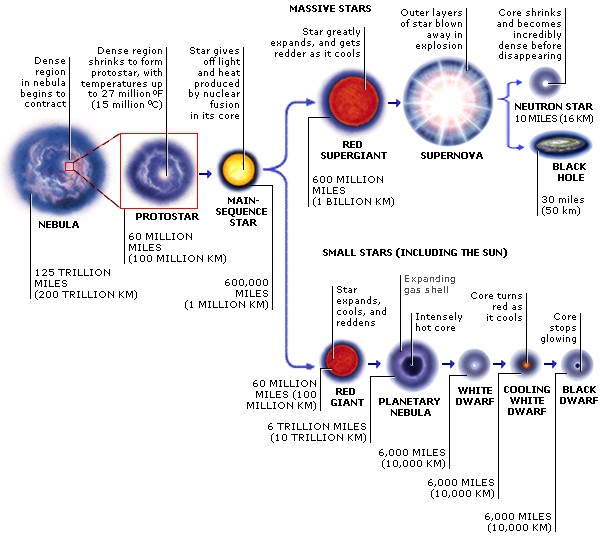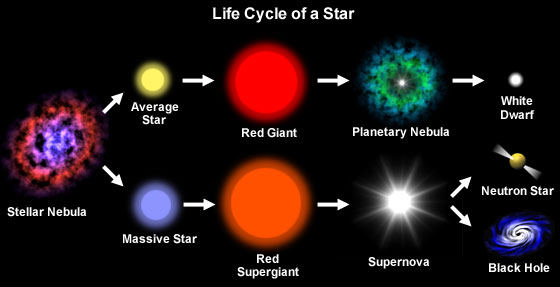June 2011 G485-Fields, Particles and Frontiers of Physics
Scroll to see replies
And there are very few similarities
more likely to compare similar radiation
oh I know they wouldnt ask for similarites/differences in a question. I was just askig generally.
Photoelectric effect - a photon with about 30keV of energy hits and electron in the tungsten atom, the electron is ejected, another electron fills the gap in the lower energy level shell, releasing a photon
Compton Scattering - a photon with about 0.5 - 5 MeV of energy hits an electron and knock it out, photon loses energy and is scattered.
Would I need to add any more info?
--------------------------------------------------------
How do radiographers try to produce a sharp image while minimising the radiation dose?
 so many interesting concepts
so many interesting conceptsThe specification's a bit vague... it just says 'describe in terms of planetary satellites'.


There's a difference?
 so many interesting concepts
so many interesting concepts
Pulses of ultrasound are sent into the body, the signal is reflected. The time of delay is used to calculate the depth. The refraction of reflection is used to identify the tissue. A-scan is just one of these. B-scan is many of these producing a better image.
Can someone give me any information on PET and CAT (like the differences between them).

X-rays came up in June '10
A-scan (amplitude scan) shows reflections as vertical deflections on the CRO screen, like a wiggly horizontal line, indicating the time the echo took to return - so you can calculate distances.
B-scan (brightness scan) shows up as dots of varying brightness. Larger amplitude of reflected waves = brighter spot. You can build a 2-d image with this but not with A-scan.
Hope this helps

onlt the contrast media and intensifiers nothing to do with compton scattering... photoelctric effect and that positron one.
Oh ok, I think I'm seeing how it works now.
What do we need to know about the mass attenuation coeffecient?

I got it from this http://www.thestudentroom.co.uk/attachment.php?attachmentid=101328&d=1305275576
It's well sick

Also these might help



Hope this helps, the pdf is useful as well it highlights like keywords and stuff
 It's good cos our book (the pizza one) is useless for that kinda thing :/
It's good cos our book (the pizza one) is useless for that kinda thing :/Thank you !
 (Jack...?) Ill definately be reading over this tonight! Good luck for tomorow!
(Jack...?) Ill definately be reading over this tonight! Good luck for tomorow!What do we need to know about the mass attenuation coeffecient?
there's an equation for it isn't there? And that isn't ultrasounds its x-rays. isn't it?
B-scan (brightness scan) shows up as dots of varying brightness. Larger amplitude of reflected waves = brighter spot. You can build a 2-d image with this but not with A-scan.
Hope this helps

Making more sense everytime I read something about it.....i hate Ultrasound.
How do you do that?
Answer in spoiler.
Spoiler
Edit- I'm not trying to test anyone or anything. I'm just confused how to get to that answer because my book says this is the answer to the question. I keep getting a different value than that.
Quick Reply
Related discussions
- A-level Physics Study Group 2022-2023
- what is Q in E=kQ/r^(2)
- aqa a levl physics derivations
- OCR GCSE Physics A Paper 4 Higher Tier (J249/04) - 16th June 2023 [Exam Chat]
- Physics A Level unit 4 questions
- Physics PHD problem
- Edexcel A Level Physics Paper 3: 9PH0 03 - 15th June 2023 [Exam Chat]
- Dr Kathy Romer answers your questions about Physics!
- Physics A Level Question Forces - electromagnetic and electrostatic force
- EPQ ideas - Physics
- A level physics Electric field question (3)
- Effect of magnetic field on pair prooduction
- Igcse physics paper 1 june 2023 edexcel | exam chat
- Alevel physics in engineering
- OCR A A-level Physics Unified Physics (H556/03) - 15th June 2023 [Exam Chat]
- MSc Nottingham Gravity particles and fields
- Aqa A level physics Electric field question (1)
- A-level Exam Discussions 2024
- UCL or Glasgow
- A level options
Latest
Last reply 3 minutes ago
Official University of St Andrews Applicant Thread for 2024Last reply 4 minutes ago
Any qualified teachers applied for funding for nursing ?Last reply 5 minutes ago
Official Dental Hygiene and Therapy (Oral Health Science) 2024 Entry Thread2808
Last reply 5 minutes ago
JK Rowling in ‘arrest me’ challenge over hate crime lawLast reply 7 minutes ago
Does saying something “Tastes professional” make sense?Last reply 11 minutes ago
Official: King's College London A101 EMDP 2024 Entry Applicants1028
Posted 12 minutes ago
AQA A-Level Chemistry Paper 2 (7405/2) - 18th June 2024 [Exam Chat]Last reply 12 minutes ago
Software Engineering Degree Apprenticeship | Digital & Technology Solutions Level 6Posted 13 minutes ago
AQA A-Level Chemistry Paper 1 (7405/1) - 10th June 2024 [Exam Chat]Trending
Last reply 3 days ago
AQA GCSE Physics Paper 1 (Higher Combined) 8464/1H - 22nd May 2024 [Exam Chat]Last reply 1 week ago
OCR A A-level Physics Paper 1 Modelling Physics (H556/01) - 24th May 2024 [Exam Chat]Last reply 4 weeks ago
AQA GCSE Physics Paper 2 (Higher Tier triple) 8463/2H - 16th June 2023 [Exam Chat]Last reply 1 month ago
AQA A-level Physics Paper 2 (7408/2) - 9th June 2023 [Exam Chat]Last reply 1 month ago
AQA GCSE Physics Paper 2 (Higher Combined) 8464/2H - 16th June 2023 [Exam Chat]Last reply 1 month ago
Edexcel A Level Physics Paper 3: 9PH0 03 - 15th June 2023 [Exam Chat]Last reply 3 months ago
AQA A-level Physics Paper 1 (7408/1) - 24th May 2023 [Exam Chat]1190
Last reply 4 months ago
Edexcel GCSE Physics Paper 1 Higher Combined 1SC0 1PH - 25th May 2023 [Exam Chat]Last reply 4 months ago
Edexcel GCSE Physics Paper 1 Higher Tier Triple 1PH0 1H - 25th May 2023 [Exam Chat]Last reply 4 months ago
AQA GCSE Physics Paper 1 (Higher Combined) 8464/1H - 25th May 2023 [Exam Chat]Last reply 5 months ago
AQA GCSE Physics Paper 1 (Higher Tier triple) 8463/1H - 25th May 2023 [Exam Chat]Last reply 5 months ago
AQA A-level Physics Paper 3 (7408/3) - 15th June 2023 [Exam Chat]Last reply 10 months ago
Edexcel GCSE Physics Paper 2 Higher Tier Triple 1PH0 2H - 16th June 2023 [Exam Chat]Last reply 10 months ago
OCR B A-level Physics Paper 3 Advancing Physics (H557/03) - 15th Jun 2023 [Exam Chat]Last reply 10 months ago
OCR GCSE Physics A Paper 4 Higher Tier (J249/04) - 16th June 2023 [Exam Chat]Last reply 10 months ago
AQA GCSE Physics Paper 2 (Foundation Combined) 8464/2F - 16th June 2023 [Exam Chat]Last reply 10 months ago
Edexcel A Level Physics Paper 1: Advanced Physics I 9PH0 01 - 24 May 2023 [Exam Chat]Last reply 10 months ago
Edexcel A Level Physics Advanced Physics II 9PH0 02 - 9th June 2023 [Exam Chat]Trending
Last reply 3 days ago
AQA GCSE Physics Paper 1 (Higher Combined) 8464/1H - 22nd May 2024 [Exam Chat]Last reply 1 week ago
OCR A A-level Physics Paper 1 Modelling Physics (H556/01) - 24th May 2024 [Exam Chat]Last reply 4 weeks ago
AQA GCSE Physics Paper 2 (Higher Tier triple) 8463/2H - 16th June 2023 [Exam Chat]Last reply 1 month ago
AQA A-level Physics Paper 2 (7408/2) - 9th June 2023 [Exam Chat]Last reply 1 month ago
AQA GCSE Physics Paper 2 (Higher Combined) 8464/2H - 16th June 2023 [Exam Chat]Last reply 1 month ago
Edexcel A Level Physics Paper 3: 9PH0 03 - 15th June 2023 [Exam Chat]Last reply 3 months ago
AQA A-level Physics Paper 1 (7408/1) - 24th May 2023 [Exam Chat]1190
Last reply 4 months ago
Edexcel GCSE Physics Paper 1 Higher Combined 1SC0 1PH - 25th May 2023 [Exam Chat]Last reply 4 months ago
Edexcel GCSE Physics Paper 1 Higher Tier Triple 1PH0 1H - 25th May 2023 [Exam Chat]Last reply 4 months ago
AQA GCSE Physics Paper 1 (Higher Combined) 8464/1H - 25th May 2023 [Exam Chat]Last reply 5 months ago
AQA GCSE Physics Paper 1 (Higher Tier triple) 8463/1H - 25th May 2023 [Exam Chat]Last reply 5 months ago
AQA A-level Physics Paper 3 (7408/3) - 15th June 2023 [Exam Chat]Last reply 10 months ago
Edexcel GCSE Physics Paper 2 Higher Tier Triple 1PH0 2H - 16th June 2023 [Exam Chat]Last reply 10 months ago
OCR B A-level Physics Paper 3 Advancing Physics (H557/03) - 15th Jun 2023 [Exam Chat]Last reply 10 months ago
OCR GCSE Physics A Paper 4 Higher Tier (J249/04) - 16th June 2023 [Exam Chat]Last reply 10 months ago
AQA GCSE Physics Paper 2 (Foundation Combined) 8464/2F - 16th June 2023 [Exam Chat]Last reply 10 months ago
Edexcel A Level Physics Paper 1: Advanced Physics I 9PH0 01 - 24 May 2023 [Exam Chat]Last reply 10 months ago
Edexcel A Level Physics Advanced Physics II 9PH0 02 - 9th June 2023 [Exam Chat]



